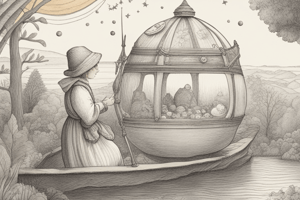Podcast
Questions and Answers
Manakah planet yang disebut sebagai dunia terdalam dan memiliki silikat logam?
Manakah planet yang disebut sebagai dunia terdalam dan memiliki silikat logam?
- Mars
- Jupiter
- Merkurius (correct)
- Venus
Planet manakah yang memiliki awan padat dan suhu yang sangat panas?
Planet manakah yang memiliki awan padat dan suhu yang sangat panas?
- Jupiter
- Bumi
- Venus (correct)
- Merkurius
Planet manakah yang merupakan satu-satunya planet yang diketahui menjadi tempat hidup?
Planet manakah yang merupakan satu-satunya planet yang diketahui menjadi tempat hidup?
- Mars
- Saturnus
- Bumi (correct)
- Venus
Planet manakah yang menampilkan lanskap merah dan matahari terbenam yang mempesona?
Planet manakah yang menampilkan lanskap merah dan matahari terbenam yang mempesona?
Planet manakah yang dikelilingi oleh sistem cincinnya yang indah?
Planet manakah yang dikelilingi oleh sistem cincinnya yang indah?
Flashcards are hidden until you start studying
Study Notes
The Wonders of Our Solar System: The Eight Major Planets
Beyond the radiant heart of our cosmic abode, the Sun, exists a grand and varied collection of celestial bodies we call planets. Each of these eight majestic entities, arrayed within distinct zones, continues to enthrall scientists and inspire curiosity about our dynamic universe.
Mercury, our innermost world, is a barren sphere encased in metal silicates, leaving little warmth and barely an atmosphere for survival. Venus, next door, sports dense clouds and scorching temperatures, obscuring any potential for hospitable environments beneath her veil.
As we venture further from the Sun, we encounter Earth. Boasting abundant liquid water and air, she remains the only planet known to harbor life. Her single moon graces skies worldwide, stirring wonderment among stargazers.
Moving onward, Mars commands attention. She presents a red landscape and features mesmerizing sunsets against the black void. Like Earth, Mars bears remnants of a once vibrant past, yet lacks the present-day vitality required to sustain living organisms.
Jupiter dominates the solar stage next, a colossal entity teeming with stormy weather and enchanting aurora displays. Notably, Ganymede, Io, Europa, and Callisto — Jupiter's quartet of captivating moons — rival Earth's Moon in beauty and uniqueness.
Saturn follows suit, resplendent in golden glory and crowned with her beguiling ring system. Titan, her biggest moon, holds much mystery due to its methane-rich environs.
Next comes Uranus, distinguished by her unexpected tilt and serene blue color. Miranda, Ariel, Umbriel, Titania, and Oberon — her beautiful progeny — offer a glimpse of her fascinating traits.
Lastly, Neptune claims residence amidst the coldest realms of the solar system, concealed beneath turquoise vistas and violent tempests. Enceladus and Triton, her children, continue to unfurl secrets about these remote regions.
These celestial marvels comprise the intimate dance of our solar family. Their unique characteristics make them the subject of ongoing studies, inspiring awe and wonder in those who look upon them or yearn to traverse their expanse.
Studying That Suits You
Use AI to generate personalized quizzes and flashcards to suit your learning preferences.





